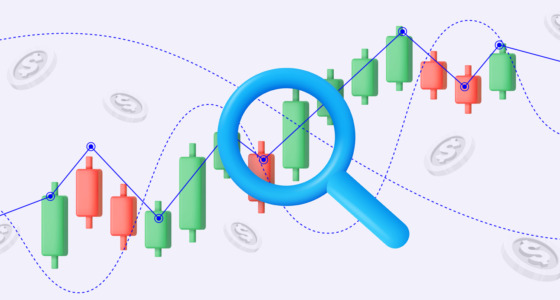

Keeping trades overnight is a challenge because of several reasons. First, the stock market is highly volatile. Thus, you should know how to measure stop-loss and take-profit levels accurately. Second, and maybe the most important pitfall, is emotions. If you don’t have significant funds and don’t know how to stay calm, there are high risks you will close the trade with losses.
Therefore, it’s better to use intraday strategies. These strategies allow you to open and close trades within one trading day. Below, you will find the best trading strategies for the Indian stock market.
Traders should be very careful, as the stock market is affected by various factors. A study showed that the Nifty index was flat the day after India won a cricket match. But a loss led the index to fall by around 0.231%. When Sachin Tendulkar, one of the leading Indian cricket players, loses, the loss on the stock market is around 20%.
1. Gap and go
Traders apply this strategy when there is a gap between the opening price and the closing price of the previous day. If the asset opens higher than on the previous day, it’s a gap up. Vice versa, if the opening price is below the closing rate of the previous day, it’s a gap down.
Usually, gaps occur due to the news events that happen when the market is closed. Therefore, the next morning, there is a gap, as investors start to react to the event. Intraday traders believe the gap will be filled by the end of the day and open a trade in the direction of the closing price.
2. Breakout
The breakout strategy is a technique that allows you to open a trade when the price goes beyond either support or resistance level. A breakout trader should find a stock that has been trading within a narrow channel for a period. As the trade is expected to be done within one day, you should consider price movements on short-term timeframes.
The idea of this strategy is to open a trade in the direction of the breakthrough. You should use indicators that reflect the size of price volume and the strength of the trend. When a breakout happens, indicators are supposed to reflect increased volumes and a strong trend.
There is a high risk of a fakeout, a false breakout. Therefore, you should use indicators and patterns that reflect the trend reversal. If the price is traded within a horizontal channel, an up or down movement will reflect the trend change.
3. Moving averages
You can also use the moving average indicator to determine entry and exit points for day trades. For this strategy, investors usually apply an exponential moving average, as it’s much faster than a simple MA.
When the price rises above the moving average, it’s a signal to open a buy position. Conversely, when the price breaks below the MA, you can sell.
You can use another strategy that also relates to moving averages. Implement two MAs with different periods on the price chart and open trades depending on their crossovers.
When the shorter-term moving average (fast MA) breaks above the MA with a bigger period (slow MA), it’s a buy signal. This pattern is called the golden cross. Vice versa, when the fast MA falls below the slow MA, a trader can sell the stock. This pattern is called the death cross.
As this strategy is used for intraday trades, you should use short periods, including 9, 12, and 21.


Tips for stock market traders
The tips below can be applied to any trading strategy listed above. They will help you to use trading strategies more effectively.
- Use short-term timeframes if you’re trading within one trading day and close the trade before the market closes. Day traders mostly use the daily chart to determine short-term stock price movements and trends.
- As you won’t keep the trade overnight, you need to choose stocks that provide high liquidity within the trading day. It’s recommended to avoid small- and medium-cap stocks, as they may suffer low liquidity. Only shares with high liquidity will allow you to trade intraday.
- Always diversify your portfolio; don’t put all your funds in one stock even if you don’t see other trading opportunities within a day. It’s better to wait and open trades the next day.
- Always determine entry and exit points in advance. Above, you see the best trading strategies for the Indian stock market. However, they can predict entry and exit points in advance. These levels are your responsibility. You need to consider the funds you operate with, the potential rewards you expect to receive from a single trade, and the possible losses you can bear for one trade. Remember that your potential rewards should be at least twice as big as losses.
- Keep in mind fundamental analysis. You can’t successfully trade on the stock market if you avoid a company’s earnings reports, mergers and acquisitions, and internal news. Track all important events that can affect the value of the stocks you trade. Avoid trading ahead of the news if you aren’t sure about its outcome.
- It’s recommended to avoid trading within the first hour after the market opens. You may hurry to open trades quickly since you will trade within the day. However, a rush may lead to significant losses. Most investors prefer opening positions between noon and 1 pm.
FAQS
Trading can raise questions even among the best of us. Here are the most common questions along with their respective answers:
· What is the easiest day trading strategy?
There are several strategies that you may use for day trading, depending on your experience level. For the most part, following a trend is the best day trading strategy, especially if you are a beginner. That being said, if you have enough experience to be able to make a quick, smart decision, scalping may be the easiest way for you to gain profit.
· What is a breakout trading strategy?
When you follow a breakout trading strategy, it means that you enter trades the moment their price breaks out of their range. As a trader, you are looking for momentum. The breakout signals that it is time for you to get into your position and benefit from the following market movement. When you place the stop, it will usually be just above your past resistance level or below the past resistance level.
· What is a momentum trading strategy?
Momentum trading strategies are when traders buy securities at a rising price and sell them when they have reached their peak. When following a momentum trading strategy, these investors will use charts to determine the potential of a specific security. Usually, this involves securities that are gaining popularity from a trend.
If data shows that this trend will begin to drop, the investor will use it to sell at the right time. The idea of momentum trading is to sell it at the highest price it could get during that specific timeframe.
· Which is the best strategy for Intraday trading?
Intraday trading involves using a series of strategies such as momentum trading, breakout trading, open high-low trading, and many more. The choice depends on your trading skills.
For example, if you have experience in reading charts and making quick yet calculated decisions, then the momentum strategy may be the best choice for you. However, if you are a beginner, then open high-low trading may be the better choice, as it offers you more leeway to learn.
· What is a reversal trading strategy?
When it comes to trading, reversals refer to a direction change in the asset price. The reversal trading strategy is employed by long-term investors and day traders alike to determine whether they should enter or exit a market.
During trend reversals, an uptrend will reverse into a downtrend, whereas a downtrend will switch into an uptrend. Using trendlines and price analysis, a trader will trade reversals that are no longer working in their favor. For example, if a trend frequently reverses, a day trader may use the reversal to purchase at the lowest price, then sell when it switches to higher prices.
Takeaway
When you enter the share market, you should consider many things, including internal company events and overall economic and political conditions. Therefore, it’s recommended to use particular trading strategies that will help to structure your trades.
Disclaimer: No strategy can guarantee a 100% correct outcome of the trade.









